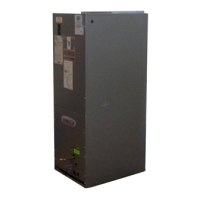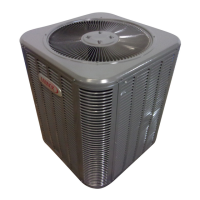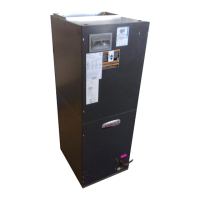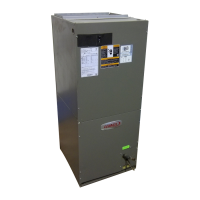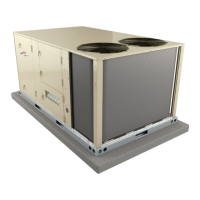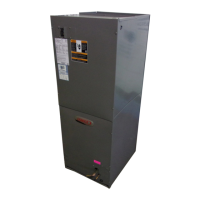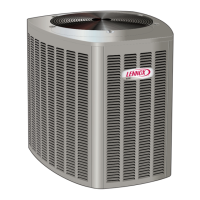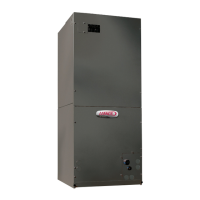Page 13
have consulted the power company and the voltage
condition has been corrected.
6 − Set the thermostat for a cooling demand. Turn on pow-
er to the indoor blower and close the outdoor unit dis-
connect switch to start the unit.
7 − Recheck voltage while the unit is running. Power must
be within range shown on the nameplate.
Charging
Units are factory charged with the amount of HCFC-22 re-
frigerant indicated on the unit nameplate. This charge is
based on a matching indoor coil and outdoor coil with a 15 ft.
(4.6 m) line set. For varying lengths of line set, refer to table 4
for refrigerant charge adjustment check.
Table 4
Liquid Line
Set Diameter
Oz. per 5 ft. (g per 1.5 m) adjust
from 15 ft. (4.6 m) line set*
5/16 in. (8 mm) 2 ounce per 5 ft. (57g per 1.5 m)
3/8 in. (10 mm) 3 ounce per 5 ft. (85g per 1.5 m)
*If line length is greater than 15 ft. (4.6 m), add this amount.
If line length is less than 15 ft. (4.6 m), subtract this amount.
The outdoor unit should be charged during warm weather.
However, applications arise in which charging must occur
in the colder months. The method of charging is deter-
mined by the unit’s refrigerant metering device and the
outdoor ambient temperature.
Measure the liquid line temperature and the outdoor ambi-
ent temperature as outlined below:
1 − Close manifold gauge set valves. Connect the man-
ifold gauge set to the service valve.
low pressure gauge to vapor valve service port
high pressure gauge to liquid valve service port
Connect the center manifold hose to an upright cylin-
der of HCFC−22.
2 − Set the room thermostat to call for heat. This will create
the necessary load for properly charging the system in
the cooling cycle.
3 − Use a digital thermometer to record the outdoor ambi-
ent temperature.
4 − When the heating demand has been satisfied, switch
the thermostat to cooling mode with a set point of 68F
(20C). When pressures have stabilized, use a digital
thermometer to record the liquid line temperature.
5 − The outdoor temperature will determine which charg-
ing method to use. Proceed with the appropriate charg-
ing procedure.
Weighing in the Charge Fixed Orifice or
TXV Systems – Outdoor Temp. < 65F (18C)
If the system is void of refrigerant, or if the outdoor ambient
temperature is cool, the refrigerant charge should be
weighed into the unit. Do this after any leaks have been re-
paired.
1 − Recover the refrigerant from the unit.
2 − Conduct a leak check, then evacuate as previously
outlined.
3 − Weigh in the unit nameplate charge.
If weighing facilities are not available or if you are charging
the unit during warm weather, follow one of the other proce-
dures outlined below.
Charging Using the Subcooling Method
Fixed Orifice Systems – Outdoor Temp.
>
65_F (18_C)
If you charge a fixed orifice system when the outdoor ambi-
ent is 65F (18C) or above, use the subcooling method to
charge the unit.
1 − With the manifold gauge hose still on the liquid service
port and the unit operating stably, use a digital ther-
mometer to record the liquid line temperature.
2 − At the same time, record the liquid line pressure reading.
3 − Use a temperature/pressure chart for HCFC-22 to de-
termine the saturation temperature for the liquid line
pressure reading.
4 − Subtract the liquid line temperature from the saturation
temperature (according to the chart) to determine sub-
cooling. (Saturation temperature − Liquid line tem-
perature = Subcooling)
5 − Compare the subcooling value with those in table 5. If
subcooling is greater than shown, recover some refrig-
erant. If subcooling is less than shown, add some re-
frigerant.

